The AMD Trinity Review (A10-4600M): A New Hope
by Jarred Walton on May 15, 2012 12:00 AM ESTAMD Trinity Gaming Performance
After the 3DMark results, you might be wondering if Intel has finally caught up to AMD in terms of integrated graphics performance. The answer is…yes and no. Depending on the game, there are times where a fast Ivy Bridge CPU with HD 4000 will actually beat out Trinity; there are also times where Intel’s IGP really struggles to keep pace. The good news is that at least everyone is now onboard the DX11 bandwagon, and compatibility with games has improved yet again for Intel. Here are our “Value” benchmark results for seven recent games; we’ll have more information in a moment.

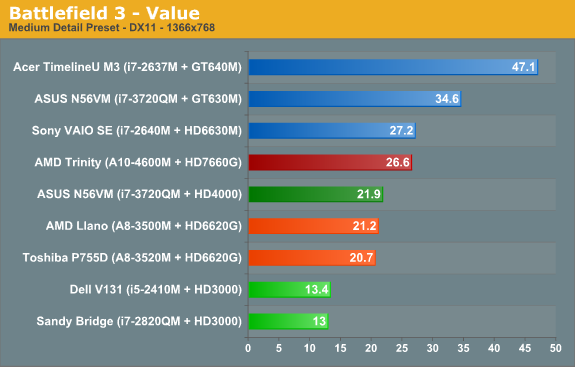
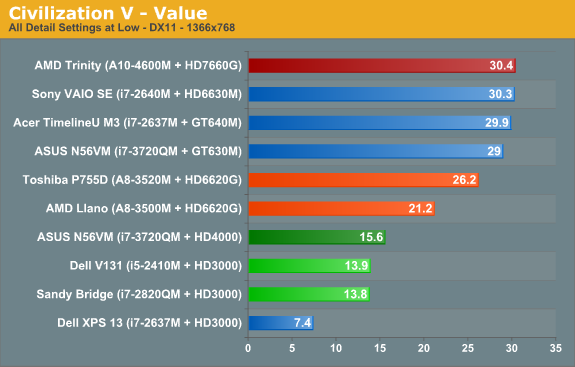

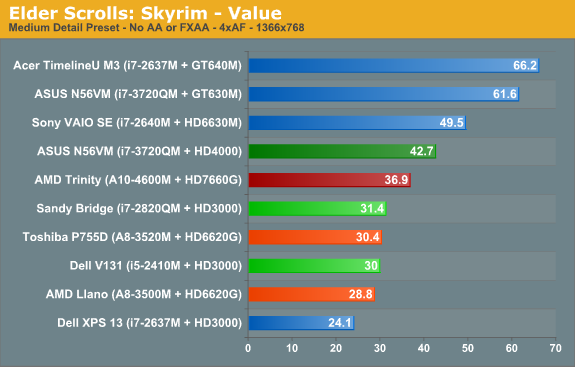
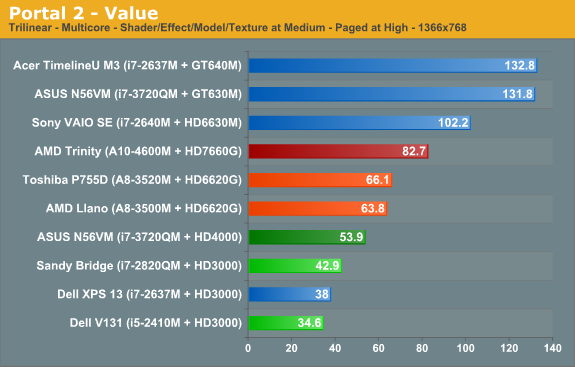
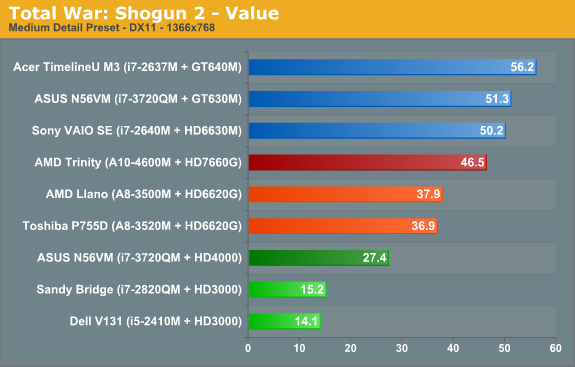
Out of our seven test titles, AMD’s Trinity leads any other IGP in four titles by a large margin. The other three titles actually have Ivy Bridge slightly ahead of Trinity, but the gaps aren’t nearly as big. Overall, the average performance across the seven games at our Value (medium) settings has AMD’s Trinity A10-4600M leading Intel’s i7-3720QM by 21%, and if we look at quad-core Sandy Bridge with HD 3000 (i7-2820QM) Trinity is 72% faster. Trinity is also around 20% faster than 35W Llano on average.
Let’s expand our gaming suite just a bit to see if things change, though. Just like we did with Ivy Bridge, we ran the eight games in our previous benchmark suite at medium detail settings. We can then compare performance across a wider 15 title selection to see how Trinity matches up against HD 4000, HD 3000, and HD 6620G (Llano). We’ll start with the bottom (HD 3000/Sandy Bridge) and move up.
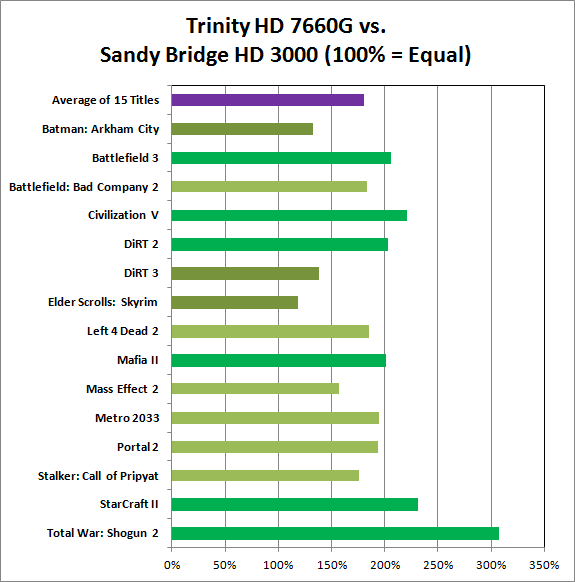
Llano’s HD 6620G was already faster than HD 3000, and Trinity’s HD 7660G is faster than Llano, so the Sandy Bridge gaming matchup is a landslide victory in AMD’s favor. The closest Intel can get is in the same three titles where Ivy Bridge leads Trinity: Batman: Arkham City, DiRT 3, and Skyrim. Here, however, HD 3000 can’t actually close the gap and HD 6620G is at least 20% faster than HD 3000, with an average performance improvement of nearly 80%.
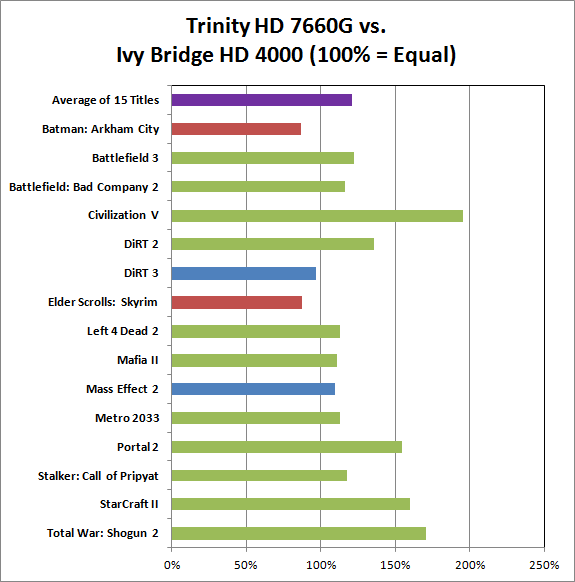
We found that across the same selection of 15 titles, Ivy Bridge and Llano actually ended up “tied”—Intel led in some games, AMD in others, but on average the two IGPs offered similar performance. This chart and the next chart will thus show a similar average increase in performance for Trinity, but the details in specific games are going to be different. Starting with Ivy Bridge and HD 4000, as with our earlier game charts we see there are some titles where Intel leads (Batman and Skyrim), a couple ties (DiRT 3 and Mass Effect 2), and the remainder of the games are faster on Trinity. Mafia II is close to our <10% “tie” range but comes in just above that mark, as do Left 4 Dead 2 and Metro 2033. The biggest gap is Civilization V, where Intel’s various IGPs have never managed good performance; Trinity is nearly twice as fast as Ivy Bridge in that title. Overall, it's a 20% lead for Trinity vs. quad-core Ivy Bridge.
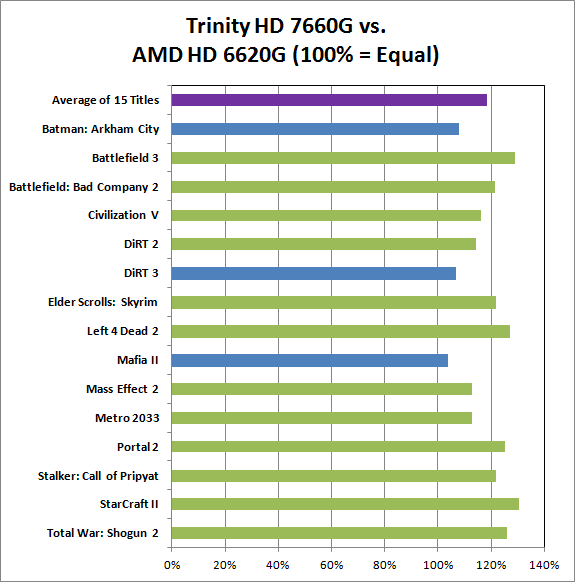
Against Llano, Trinity is universally faster, but the smallest gap is in Mafia II (3%) while the largest gap is in StarCraft II (30%). On average, looking at these games Trinity is only 18% faster than Llano. What’s not entirely clear from the above chart is whether we’re hitting CPU limitations, memory bandwidth limitations (remember that Llano and Trinity share bandwidth with the rest of the system), or perhaps both. At our chosen settings, what is clear is that Trinity’s “up to 56% faster” graphics never make it that high.
We saw 35-45% higher scores in 3DMark 11 and Vantage, which tend to remove the CPU from the equation more than actual games, so our guess would be that if AMD continues with their APU plan they’re going to need to work more on the CPU side of the equation. We also see the same thing looking at the VAIO SE scores in the earlier gaming charts: the HD 6630M scores are 20% faster on average, but much of that appears to come from the faster CPU rather than the GPU.










271 Comments
View All Comments
medi01 - Thursday, May 17, 2012 - link
That's simply BS, my dear.Most of the "starting" task is HDD bottlenecked.
Having a lot of apps loaded is RAM constrained.
It has ABSOLUTELY NOTHING to do with CPU power.
B3an - Thursday, May 17, 2012 - link
Yeah because the CPU just does nothing, at all, ever. It just sits there totally idle all the time right.medi01 - Friday, May 18, 2012 - link
That's exactly what modern CPUs do (for quite a while) in a majority of PCs most of the times: IDLE. You didn't know that? Oh well. (Gamers being an exception)I encode video a lot (so far the most CPU extensive task besides gaming that you can imagine at home, which seems to be shifting towards GPU though) and even that is a "batch" task, I couldn't care less whether it is finished at 2pm or 3pm at night.
sviola - Tuesday, May 15, 2012 - link
Well, load eclipse or Visual Studio, a local DB server, a local application server, a few browser windows, some spreadsheets and documents, a couple of IM and some terminal windows and you got my usual work setup running. It can be demanding on the CPU and sometimes make the system slow down. And waiting for the system to respond can be frustrating in these situations, not mentioning having to compile all the project...mpschan - Tuesday, May 15, 2012 - link
Are you really expecting to do all that processing on a 500-700 dollar laptop? You're clearly doing work-related activities, which is not the target consumer here.Spunjji - Wednesday, May 16, 2012 - link
+100. Tired of this ass-hattery.mikato - Wednesday, May 16, 2012 - link
I think your biggest problems there would be Eclipse/Visual Studio. Also if you're using MS SQL Server as the DB (with Management Studio?) then definitely that too. And I don't know what app server you mean. Compiling projects? This stuff can be slow on a desktop, come on. How about using a lighter IDE or Notepad++ or MySQL for the DB.... or doing this work on a desktop like everyone else.medi01 - Thursday, May 17, 2012 - link
Mentioned example sickens me. I do similar stuff. Except I also have virtual machine running on top of things.NOT ENOUGH RAM is what you get in these situation, not slow CPU!!!!
CeriseCogburn - Thursday, May 24, 2012 - link
Well then all core 2 / duo users can just upgrade their ram no need for this trinity laptop crap.No buying anything but some cheap ram.
Glad to hear it.
xd_1771 - Tuesday, May 15, 2012 - link
BSMonitor, none of those tasks are CPU intensive and will consume less than 50% of that CPU.Your analogy is completely backwards. With programs INCLUDING video playback programs (seriously, I want you to name a popular video codec that isn't going to be accelerated by this GPU - this standard has existed for a number of years), office programs (Office 2010 and up) and pretty much every major web browser in existence having moved onto making large use of GPU acceleration, CPU will start ceasing to matter. The Trinity APU is very well balanced for the performance on both sides that it offers.
With more TRUE cores to balance non-intensive CPU workloads around than the competition, it arguably offers much better multitasking ability.